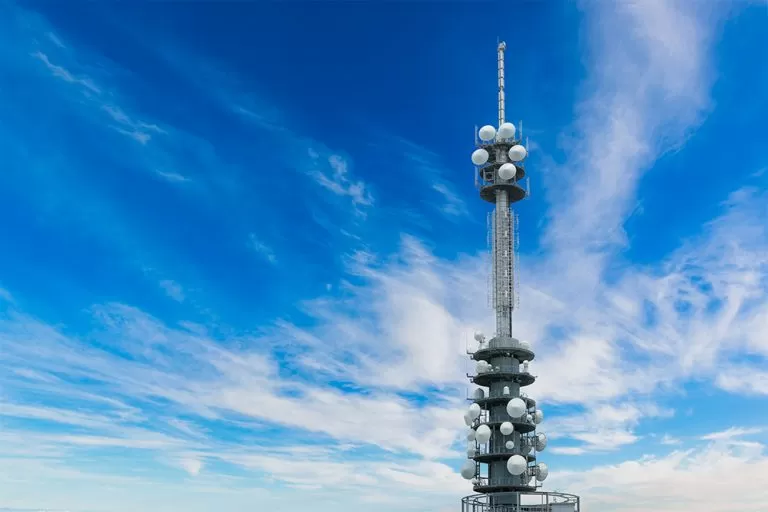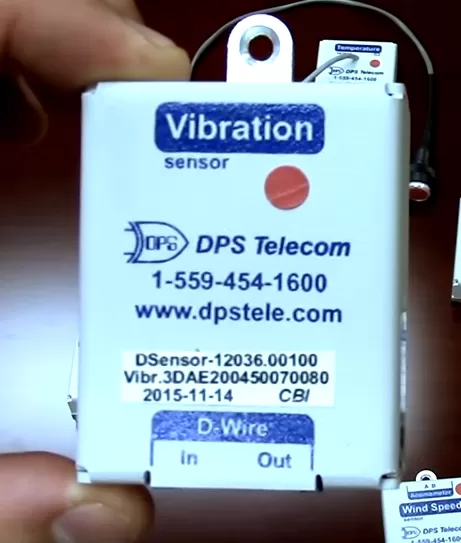Download our free Monitoring Fundamentals Tutorial.
An introduction to Monitoring Fundamentals strictly from the perspective of telecom network alarm management.
1-800-693-0351
Have a specific question? Ask our team of expert engineers and get a specific answer!
Sign up for the next DPS Factory Training!

Whether you're new to our equipment or you've used it for years, DPS factory training is the best way to get more from your monitoring.
Reserve Your Seat TodayMicrowave links are critical infrastructure for telecom companies that need to traverse long distances. In one common example, you'll see microwave links routing traffic from mountaintop to mountaintop to cross mountain ranges.
It environment like this just isn't practical to actually lay physical wire. Microwave is more efficient and, because radio waves travel at the speed of light, faster.

I've traveled a wide range of microwave sites with DPS clients. They're among some of the most isolated sites you can imagine. Very massive inspiration for us to DPS as we work to make remote monitoring equipment that is easy to set up and will work reliably throughout winters that are often covered in deep snow.
In particular, one client I worked within the frigid north of North America has some amazingly cold and remote sites. They absolutely, positively need remote monitoring for their microwave links that is 100% reliable.
To give you a sense of some of the challenges that they're facing, one technician at this company, Brian, brought me an incredibly surprising question. He wanted to know whether DPS would be able to provide a system to detect and report gunfire entering the building.
Why in the world would they need this? Well, as it turns out, hunters in the very remote sections of Alaska often get bored out there. They decided that it would be a good idea to take a few "practice shots" at the only noticeable target in sight: a telecom hut.
After several incidents, Brian and his colleagues decided to install Kevlar curtains along the interior walls of the building. The goal here was to catch bullets before they cause damage to the equipment and the site. You don't often expect your microwave links to be under threat from gunfire, but that was the reality for this company.
In an effort to catch not just the bullets but also the shooters in the act, Brian approached DPS about the possibility of installing some kind of seismic or noise sensor inside the site to detect an impact on the Kevlar curtains.
In the end, we agreed that a DPS vibration sensor could conceivably work, but there was some fear that the duration of the bullet-induced vibrations would not be long enough to trip the sensor. We settled on something more like a glass-break sensor that you would see in a security system.

So, what are some of the key things that you must monitor at your microwave link sites?
Well, the first thing that you must monitor is all of the same things that you would monitor any remote site. Think of your generators, UPS batteries, commercial power source (if available), or maybe solar panels. Think about all of your telecom equipment that is needed to supply data to and from the microwave link itself.
Next, obviously you need to monitor the microwave transmitters contained in the site. You're also going to have a tower, that probably falls under FAA/FCC regulations for obstruction lighting. Those regulations mandate that you monitor the tower lights in one of two ways.
While it's legally permissible to have a human being look at the lights once every 24 hours to confirm they're operational, who wants to do this? We're talking about a site that's very, very remote. By definition, this is going to be something that's difficult to reach.
Even if you happen to live next to a site in a rural area, or you can pay a farmer to check it for you, there's no denying that an automated monitoring system that will detect the tower light failure within seconds is superior.
Minimum compliance with the tower light regulations isn't your only goal here. You need to think about legal and moral liability that can result from an aircraft incident if your lights go down.
A remote monitoring device is your best option for tower light monitoring and is really almost no incremental cost when you consider that you need remote monitoring for your microwave link and other systems as well.

So now that you've installed in RTU at your microwave link site, you need a way for the alarm data to get back to you.
Obviously, some microwave sites may have wired network access. This is common at the first site in a microwave chain because this one is necessarily near your core network. If you can use this most-reliable form of LAN, you should absolutely do it.
But what about sites up on mountaintops like we've described before? The whole point here is that your microwave links were constructed to circumvent having any kind of wired connectivity. How do you monitor them?
In this case, you looking for some kind of wireless connectivity to backhaul your alarms back to your NOC center.
The most obvious thing that you should set up first is to use an overhead network channel that is commonly made available by your microwave manufacturer. This will give you some amount of bandwidth, usually plenty for simple remote monitoring data, to send your alarms back home.
But what happens when your microwave links are down? That's the time you absolutely need remote monitoring, so you can't afford to have it go dark at that precise moment.
To handle this scenario properly, you need some kind of backup wireless communications method. There are really three options here.
The cheapest over the long run will usually be private radio. This is suitable for very large organizations, who can usually achieve the economy of scale necessary to make operating their own private radio network successful. Private radio ends up being cheap because there are no ongoing fees. You own the network, so you don't have to pay any kind of operator any monthly fee.
The next option, and usually the most common, is to use the wireless phone networks to backhaul your alarms from your microwave link RTU. You generally won't do this for all traffic, but rather as a backup method for when the microwave link is down.
This method works pretty well and is not very expensive with low-traffic data plans, but obviously becomes impossible if you don't have wireless coverage in your area. This can happen at remote mountaintop sites.
That's where your last option comes in: satellite. Despite being the most expensive option you have available, satellites actually got much cheaper recently.
I worked extensively with the power utility on the East Coast who used this effectively. We were using a T/Mon master station to poll NetGuardian DIN via satellite service provided by X2nSat.
The monthly fee for this user polling the RTU every two minutes was about $60. When you consider that this connectivity is available anywhere in the world, that's not a ridiculous price to pay.
If you do plan to look at satellite, consider every opportunity to reduce the amount of data transfer you use. It's almost as if the satellite is following the same price trajectory as terrestrial wireless, but about 20 years behind it.
I hope this discussion has been helpful for you as you plan to protect your microwave link sites with top-quality remote monitoring. Don't wait for a preventable incident to take your next step.
To get started fast, please contact me or any other DPS engineer to discuss what you're trying to accomplish.